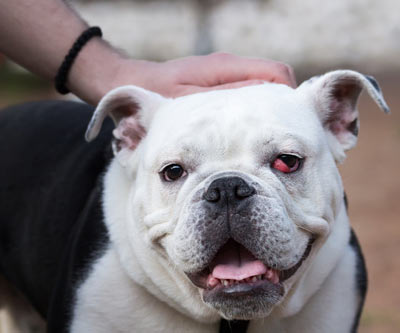Cherry Eye in Dogs

Have you ever seen your dog's "third eyelid" come up, covering the eye with a white membrane that is usually only visible as a small white triangle in the inner corner of the eye?
That third eyelid, or nictitating membrane, houses a tear gland. Sometimes that tear gland prolapses, or escapes its area, and becomes visible constantly. This appears as a bulbous, red "growth" erupting from below your dog's bottom eyelid.
When this happens, it's called a prolapsed gland of the nictitans, or a cherry eye.
Why Do Dogs Have a Third Eyelid?
The third eyelid and the gland within it are meant to protect a dog's eye from foreign debris and keep it well-lubricated. You will sometimes see the third eyelid rise up to cover the dog's cornea momentarily, to protect it.
If a dog has an eye injury, such as a corneal ulcer, the third eyelid might go up and stay up, in an attempt to repair the damage and prevent further irritation. If your dog's white third eyelid is covering part of the eye and not going down, make an appointment with your veterinarian.
This is different from a cherry eye, in which the tear gland within the third eyelid, specifically, prolapses.
What Causes Cherry Eye in Dogs?
Trauma to the head or eye can cause prolapsed third eyelid glands. Most times, however, the problem occurs without trauma, and it's likely that it has to do with the eye conformation of the dog. Members of certain dog breeds are more prone to cherry eye, and most of those breeds are brachycephalic, or have shortened noses and more pronounced eyeballs. These breeds include:
- Boston terriers
- Bulldogs
- Cocker spaniels
- Lhasa apsos
Most dogs develop cherry eye before the age of two.
Diagnosis of Cherry Eye in Dogs
A cherry eye can be diagnosed easily simply by looking at the dog's eye and seeing the prolapsed gland, which looks like a small cherry sitting on top of the dog's lower eyelid, in the inner corner.
When your dog is suffering from cherry eye, your veterinarian will do a thorough eye exam to check for other problems that may be concurrent or the result of the cherry eye. For instance, if the dog has been rubbing at the cherry eye, he might have caused a corneal ulcer, a scratch on the surface of the eye.
Chronic cherry eye can result in KCS, or dry eye syndrome because the prolapsed tear gland isn't able to properly lubricate the eye.
Treatment of Canine Cherry Eye
Dogs with a prolapsed third eyelid gland almost always require surgery. The surgeon replaces the gland where it belongs, under the lower eyelid, and tacks it in place.
Sometimes, the tack doesn't hold after surgery and the prolapse recurs.
Some surgeons remove the third eyelid gland as a treatment for cherry eye, but this is quite likely to result in chronic dry eye syndrome, which will need treatment for the rest of the dog's life.
Dogs with cherry eye should not be bred, due to the strong evidence of a hereditary basis for this condition.
You May Also Like These Articles:
Otitis Externa: Ear Infections in Dogs
Good Small Breed Dogs for First Time Dog Owners: Slideshow
Use Your Voice and Body Language to Make Your Dog Happy
Which Dog Breeds Shed the Least?
Disclaimer: This website is not intended to replace professional consultation, diagnosis, or treatment by a licensed veterinarian. If you require any veterinary related advice, contact your veterinarian promptly. Information at DogHealth.com is exclusively of a general reference nature. Do not disregard veterinary advice or delay treatment as a result of accessing information at this site. Just Answer is an external service not affiliated with DogHealth.com.
Notice: Ask-a-Vet is an affiliated service for those who wish to speak with a veterinary professional about their pet's specific condition. Initially, a bot will ask questions to determine the general nature of your concern. Then, you will be transferred to a human. There is a charge for the service if you choose to connect to a veterinarian. Ask-a-Vet is not manned by the staff or owners of DogHealth.com, and the advice given should not delay or replace a visit to your veterinarian.



